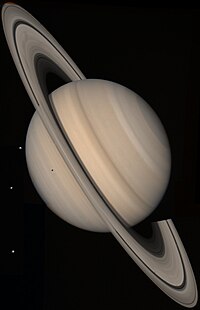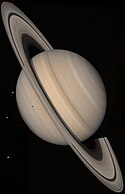Przerwa Cassiniego
Przerwa Cassiniego - największa z przerw widocznych w pierścieniach Saturna, o szerokości 4 800 km. Znajduje się ona pomiędzy jasnymi pierścieniami A i B. Przerwa została odkryta przez Giovanniego Cassiniego w 1675 roku. Jest dobrze widoczna już przez niewielki teleskop.
Budowa

Przerwa Cassiniego nie jest rzeczywistą szczeliną w pierścieniach planety, ale obszarem gdzie materia krążąca wokół planety jest ciemniejsza niż w sąsiednich pierścieniach. Ma ona złożoną strukturę wewnętrzną; znajdują się w niej rzeczywiste szczeliny, spośród których najszersze są przerwa Huygensa (po wewnętrznej stronie, oddziela pierścień B) i przerwa Laplace'a, oraz pasma materii o zróżnicowanej szerokości i jasności. Przerwę Huygensa tworzy rezonans orbitalny 1:2 z księżycem Mimasem, który destabilizuje orbity cząstek, które znajdą się w tym obszarze, jednak także tam znajduje się wąski pierścień materii.
| ||||||
Media użyte na tej stronie
This true color picture was assembled from Voyager 2 Saturn images obtained Aug. 4 [1981] from a distance of 21 million kilometers (13 million miles) on the spacecraft's approach trajectory. Three of Saturn's icy moons are evident at left. They are, in order of distance from the planet: Tethys, 1,050 km. (652 mi.) in diameter; Dione, 1,120 km. (696 mi.); and Rhea, 1,530 km. (951 mi.). The shadow of Tethys appears on Saturn's southern hemisphere. A fourth satellite, Mimas, is less evident, appearing as a bright spot a quarter-inch in in from the planet's limb about half an inch above Tethys; the shadow of Mimas appears on the planet about three-quarters of an inch directly above that of Tethys. The pastel and yellow hues on the planet reveal many contrasting bright and darker bands in both hemispheres of Saturn's weather system. The Voyager project is managed for NASA by the Jet Propulsion Laboratory, Pasadena, California, United States.
This view from the Cassini spacecraft provides a crisp look at the fine material and detailed structure in the Cassini Division that is not readily visible from the Earth. The faint F ring, just visible between Mimas and the A ring, bounds the main rings of Saturn.
Mimas is 397 kilometers (247 miles) across.
This view looks toward the sunlit side of the rings from about 4 degrees below the ringplane.
The image was taken in visible green light with the Cassini spacecraft narrow-angle camera on Sept. 7, 2007. The view was acquired at a distance of approximately 2.9 million kilometers (1.8 million miles) from Saturn. Image scale is 18 kilometers (11 miles) per pixel on Mimas.

